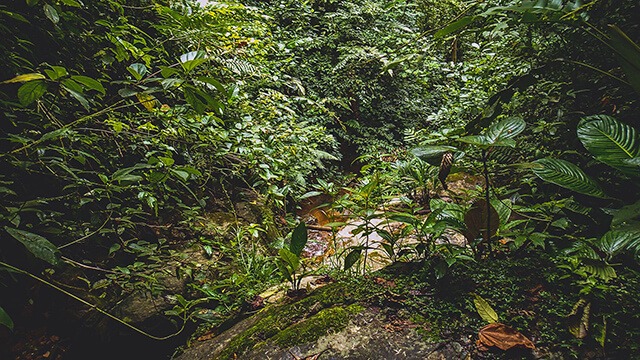- October 04, 2018
- By Matthew E. Wright
Amphibian biologists around the world watched in horror in 2004 as the frogs of El Copé, Panama, began dying by the thousands. The culprit: Batrachochytrium dendrobatidis, more commonly known as chytrid fungus. Within months, roughly half of the frog species native to the area went locally extinct.
A new study led by University of Maryland researchers suggests that, within a decade, the species remaining in El Copé developed the ability to coexist with chytrid fungus. In a field study spanning 2010–14, the researchers found that frogs infected with the fungus survived at a nearly identical rate compared with uninfected frogs.
The results, published yesterday in Ecological Applications, suggest that frog populations in El Copé underwent ecological and/or evolutionary changes that enabled the community as a whole to persist, despite severe species losses. According to the researchers, the results could mean good news for other hot spots of amphibian biodiversity hit hard by chytrid fungus, such as South America and areas of Australia.
“Our results are really promising because they lead us to conclude that the El Copé frog community is stabilizing and not drifting to extinction,” said Graziella DiRenzo Ph.D. ’16, now a postdoctoral researcher at the University of California, Santa Barbara, and the lead author of the research paper.
DiRenzo and her colleagues returned to the same small, 2-square-kilometer field site in El Copé every year and broke the area into 20-meter subsites, repeatedly sampling them for frog abundance, number of species present and chytrid infection status. Each time, the researchers tested individual frogs for the presence of the fungus while assessing the severity of any disease symptoms.
The results led the researchers to conclude that infected frogs were surviving at the same rate as uninfected frogs. This observation strongly suggested that the frog species remaining in El Copé developed the ability to tolerate the fungus and survive its deadly effects.
“Our study found that, even though there are a lot of infected individuals, about 98 percent of them are infected at very low levels,” said Karen Lips, a professor of biology at UMD and senior author of the study. “We know that, early on, several species played a key role in spreading infection, like Typhoid Mary. But some of these species are now gone, so the entire ecosystem is totally different. It’s almost not comparable to what was there before.”
If the community has stabilized here, the researchers say, it is likely that other devastated frog communities elsewhere underwent similar adaptations—even where disease has reduced the overall number of species and/or individuals.
“The frogs of El Copé are not doing great, but they’re hanging on. The fact that some species survived is the most important thing,” Lips said. “If a species goes extinct right off the bat, it’s out of options. …If enough frog species in a given place can survive and persist, then hopefully someday a vibrant new frog community will replace what was lost.”
Topics
Research